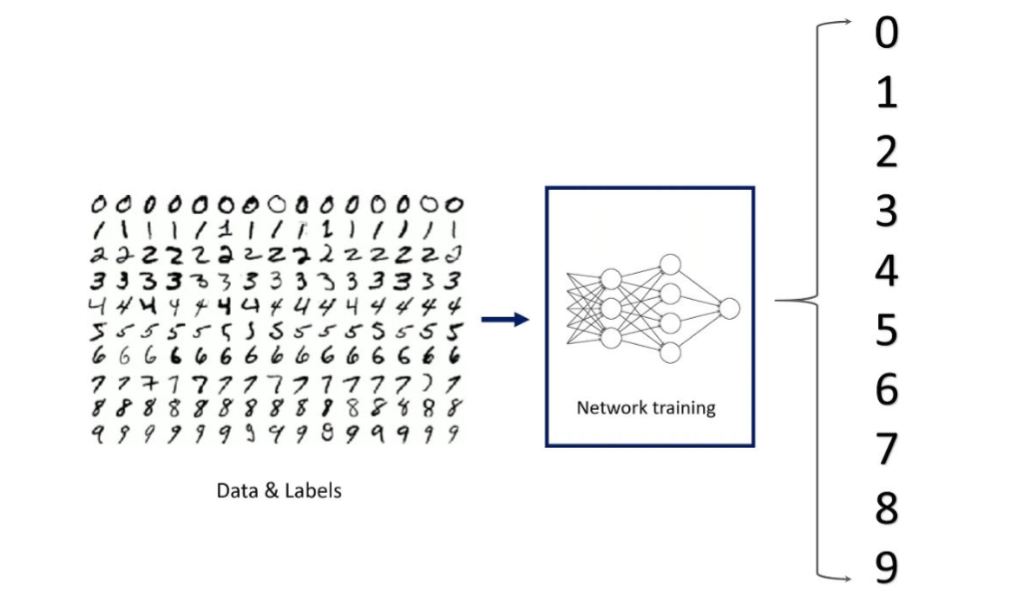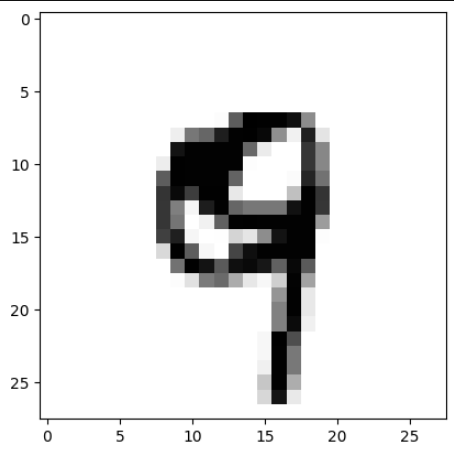# Assignment
Our trained model should predict on which number is written.
The output should look like the following:

# Implementation
Get MNIST-dataset
import matplotlib.pyplot as plt
import tensorflow as tf
(x_train, y_train), (x_test, y_test) = tf.keras.datasets.mnist.load_data()visualization
%matplotlib inline
image_index = 7777
print(y_train[image_index])
plt.imshow(x_train[image_index], cmap='Greys')= 8
get to know dataset shape
x_train.shape= (60000, 28, 28) - amount of data, size of image
reshaping & normalizing
# Reshaping the array to 4-dims so that it can work with the Keras API
x_train = x_train.reshape(x_train.shape[0], 28, 28, 1)
x_test = x_test.reshape(x_test.shape[0], 28, 28, 1)
input_shape = (28, 28, 1)
# Making sure that the values are float so that we can get decimal points after division
x_train = x_train.astype('float32')
x_test = x_test.astype('float32')
# Normalizing the RGB codes by dividing it to the max RGB value.
x_train /= 255
x_test /= 255
print('x_train shape:', x_train.shape)
print('Number of images in x_train', x_train.shape[0])
print('Number of images in x_test', x_test.shape[0])= x_train shape: (60000, 28, 28, 1) Number of images in x_train 60000 Number of images in x_test 10000
build convolutional neural network
# Importing the required Keras modules containing model and layers
from tensorflow.keras.models import Sequential
from tensorflow.keras.layers import Dense, Conv2D, Dropout, Flatten, MaxPooling2D
# Creating a Sequential Model and adding the layers
model = Sequential()
model.add(Conv2D(28, kernel_size=(3,3), input_shape=input_shape))
model.add(MaxPooling2D(pool_size=(2, 2)))
model.add(Flatten()) # Flattening the 2D arrays for fully connected layers
model.add(Dense(128, activation=tf.nn.relu))
model.add(Dropout(0.2))
model.add(Dense(10,activation=tf.nn.softmax))compiling & fitting the model
model.compile(optimizer='adam',
loss='sparse_categorical_crossentropy',
metrics=['accuracy'])
model.fit(x=x_train,y=y_train, epochs=30)= Epoch 1/10 1875/1875 ━━━━━━━━━━━━━━━━━━━━ 23s 12ms/step - accuracy: 0.6364 - loss: 122.8531 Epoch 2/30 1875/1875 ━━━━━━━━━━━━━━━━━━━━ 22s 12ms/step - accuracy: 0.6373 - loss: 1.2093
evaluating
model.evaluate(x_test, y_test)313/313 ━━━━━━━━━━━━━━━━━━━━ 2s 5ms/step - accuracy: 0.9617 - loss: 0.2242 … Acc. ~ 96%
prediction for image
image_index = 4444
plt.imshow(x_test[image_index].reshape(28, 28), cmap='Greys')
pred = model.predict(x_test[image_index].reshape(1, 28, 28, 1))
print(pred.argmax())= 1/1 ━━━━━━━━━━━━━━━━━━━━ 0s 72ms/step 9
